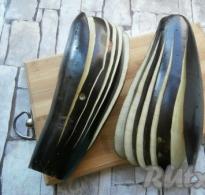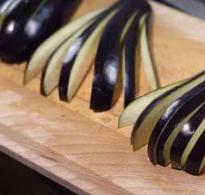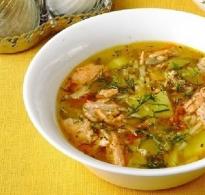Plain vinegar instead of rice vinegar. Sushi rice dressing
Sushi came to us, as you know, from Japanese cuisine, in which each ingredient plays a special role. Often, people who decide to cook sushi on their own wonder - what is rice vinegar for sushi and how to use it correctly? Indeed, in recipes, he is usually necessarily mentioned. You can find the answer to this question with us, we will tell you about the correct use of this product so that you are definitely not mistaken! How much rice vinegar to add? What does it taste like? The questions will be covered in detail, and you will be pleasantly surprised if you prepare everything according to our recommendations.
What is it and how to use it?
Rice vinegar has a sweetish taste, it is quite soft and without it, and not sushi at all, the Japanese definitely know a lot about cooking. How much rice vinegar you need, no one can tell you for sure, because everyone has their own secrets, so try experimenting.
Vinegar is added to flavor the rice and makes it a little sticky. This will help you shape the rice for a wide variety of shapes. How much vinegar is required to make the rice sticky enough is also worth determining when cooking. A lot depends on how much rice vinegar you add, and one of the nicest things is that it is very healthy and even antibacterial.
But how much is it?
To make a rice vinegar dressing, you need sugar and salt. For 450-500 g of rice, you need to put 2 tablespoons. vinegar and 1 tsp. salt and sugar. Without bringing to a boil, stir the dressing, then sprinkle the rice with this mixture or simply water it using wooden utensils. Stir gently without applying pressure, so as not to accidentally cook porridge.
Rice vinegar is a healthy product that is used to prepare oriental dishes. This is a must-have ingredient for rolls and sushi, which cannot be excluded from the recipe, but can be replaced.
Rice vinegar - properties and application features
There are many types of vinegars - wine, apple, rice, balsamic, table vinegars. Each has its own characteristics:
- White wine vinegar is softer than balsamic vinegar and adds an interesting touch to salads, sauces, meat. Its variety is grape vinegar. It has a sweet and sour taste and a light aroma.
- Apple cider vinegar is recognizable in dishes due to its light sour-fruity taste and delicate aroma.
- Balsamic vinegar is dark and thick with a sweet and sour taste. It is suitable for dressing soups, salads and desserts.
- Table vinegar cannot be confused with anything, as it has a pungent odor and a scalding sour taste. Among other vinegars, it is the most concentrated. This is a synthetic product, however, vinegar is popular due to its low cost and is used in pickling vegetables, fruits, meat, as a salad dressing.
- Rice vinegar has the most delicate flavor. It is used for marinating fish, dressing salads and sauces, for making rolls and sushi.
Rice vinegar is used to prepare a dressing for sushi and roll rice
Rice vinegar has a mild flavor and delicate aroma and is less acidic than other types of vinegar. It is a dietary product with health benefits.
- Does not damage the gastric mucosa, is not contraindicated for people with diseases of the digestive system.
- Contains amino acids and trace elements, helps to eliminate toxins from the body.
- Promotes the normalization of metabolism.
Rice vinegar in sushi is not a common ingredient that can be eliminated. It has an important function - it holds rice and algae together. If it is not possible to use it during the preparation of rolls or sushi, there are two options:
- make your own rice vinegar;
- replace it.

Rice vinegar is a healthy dietary product
How can you replace it in sushi and roll recipes
Sushi and rolls are especially fond of gourmets. Many people want to eat at no cost by cooking them with their own hands. Sometimes it is difficult to buy vinegar, which plays the role of dressing in dishes, due to its lack in the store or the high price. It is not recommended to exclude it from the recipe, since the end result is unlikely to please. But you can replace it. Apple cider vinegar, wine (white or grape) vinegar, as well as ginger marinade or lemon juice are considered good substitution options in the preparation of sushi and rolls. Calculate the amount of dressing and rice in a 1: 5 ratio. In general, you can add it to rice to taste.
Ideal substitutes - gallery
 Apple cider vinegar is a budget substitute for rice
Apple cider vinegar is a budget substitute for rice  Grape vinegar with salt and sugar can be included in roll recipes instead of rice vinegar
Grape vinegar with salt and sugar can be included in roll recipes instead of rice vinegar  Lemon juice - an alternative to rice vinegar in oriental dishes
Lemon juice - an alternative to rice vinegar in oriental dishes
Apple cider and wine vinegar dressing
Making an apple cider vinegar dressing can add a delicate flavor and fruity aroma to your rice. You will need the following ingredients:
- vinegar - 2 tbsp. l .;
- sugar - 2 tsp;
- salt - 1 tsp;
- hot water - 3 tbsp. l.
Combine apple cider vinegar, sugar and salt in a saucepan. Add hot water and stir the ingredients well until a smooth dressing is obtained.
White wine vinegar is also a great substitute for rice vinegar, as they are similar in taste and aroma.
Please note: this recipe uses nori seaweed, not kelp (seaweed)!
List of required products:
- 2.5 tbsp. l. wine vinegar;
- 2.5 tbsp. l. Sahara;
- ½ tsp salt;
- 1 sheet of nori.
Mix all the ingredients and heat the mixture, add the crumbled nori leaf. Whisk the ingredients until smooth. If you cook a dressing with nori, then you don't need to add it when cooking rice for sushi and rolls.

Nori wine vinegar is a great sushi dressing
Video - cooking rice dressing
Lemon juice will saturate the rice for rolls well and add a pleasant sourness to the taste. You will need products:
- lemon juice - 2 tbsp. l .;
- sugar - 1 tsp;
- warm water - 2 tbsp. l .;
- salt - ½ tsp.
Pour in 2 tbsp. l. warm water in lemon juice, add sugar and salt and mix everything thoroughly.

Lemon juice soaks well the rice used for making sushi, rolls
Controversial options: unusual balsamic and ordinary dining
Chefs agree that balsamic vinegar is not suitable for dressing sushi and rolls, since it changes the taste of rice to a bright herbal one. But there is still no consensus on the canteen. His opponents do not recommend this kind of impregnation for rice. Others are more optimistic and believe that with skillful preparation, the substitution is not felt. In addition, adding soy sauce will soften the harshness of the taste and smell. The dressing recipe is simple. Have to take:
- 50 ml of table vinegar (6%);
- 20 g sugar;
- 50 ml of soy sauce.
Mix all ingredients thoroughly in a bowl.
If there is no way to use another substitute, you can try this recipe. However, in this case, one should not rely on the sophistication of taste and aroma. The main thing is not to overdo it and stick to proportions.
Cooking rice vinegar at home
If you do not intend to buy rice vinegar and do not want to use substitutes, then make it at home. True, you should be patient, since you will have to spend time and effort on cooking.
For cooking, you need the following ingredients:
- round rice - 300 g;
- sugar - 900 g;
- dry yeast - 1/3 tbsp. l.
Cooking procedure:
- Rinse the rice in cold water and pour 1.2 liters of water. Use glassware.
- Leave the rice warm for 4-5 hours, and then transfer to the cold for 4 days.
- Strain the rice and add 900 grams of sugar.
- Insist the mixture in a water bath for 30 minutes, then cool and pour into a jar.
- Add yeast, previously diluted in warm water, according to the instructions on the package.
- Insist the mixture for a month (do not close the jar with a lid, but use gauze for this).
- Strain and boil the composition.
The volume will be sufficient for several applications.

Rice vinegar can be made at home
Also, rice vinegar is used to marinate seafood and fish. It is better suited for such products, since it does not drown out their natural aroma and taste, but only adds a slight sourness.
Options for marinating meat, fish, ginger
When pickling ginger, rice is traditionally used, it can be replaced with apple cider or grape vinegar, diluted to a 4% concentration. Stores have a concentration of 9%. To obtain a solution of 4% concentration, you need to dilute them with boiled water: 1 part vinegar 1.5 parts water.
A substitute for marinating seafood or meat is impregnation with lemon juice, previously mixed with sugar dissolved in boiled water:
- lemon juice - 4 tbsp. spoons;
- boiled water - 4 tbsp. spoons;
- sugar - 2 tsp.
Before marinating, seafood is thawed and boiled for 2-3 minutes in salted water:
- prepare the lemon, sugar and water marinade using the proportions described above;
- put the cooled seafood in a small container;
- add 1 tbsp. a spoonful of vegetable oil (for 2 tsp. lemon marinade), add spices if desired;
- stir by hand, evenly distributing the ingredients and close the container with a lid;
- leave for 10-12 hours in a cool dark place.

When pickling ginger, rice vinegar can be substituted for grape or apple cider vinegar.
Video recipe - pickled ginger
Do not give up the idea of cooking and trying tasty and healthy dishes just because unfamiliar food names are intimidating. Make sushi and rolls at home at no significant cost by replacing rice vinegar with apple cider, wine, and lemon juice. If you intend to achieve a taste close to the original, make your own rice vinegar.
Rice vinegar is a key ingredient in Japanese cuisine. If you prefer to cook rolls and sushi with your own hands, you cannot do without this ingredient.
Firstly, it has a very delicate delicate taste that perfectly emphasizes the dish. Secondly, this vinegar has antibacterial properties. This is very important, because raw fish is often present in sushi and rolls.
How to replace rice vinegar
Inexperienced cooks sometimes replace rice vinegar with wine, apple cider, or even regular vinegar. Here they make a mistake, since the taste of these spices is very different and you can easily ruin the dish. There are several different recipes for making a great alternative to rice vinegar.
50 ml of table vinegar;
50 ml soy sauce;
20 g sugar.
Combine all the ingredients in one container and stir until the sugar is completely dissolved.
4 tbsp. l. grape vinegar;
3 tsp Sahara;
1 tsp salt.
Combine the ingredients and put the mixture on low heat. Stir to dissolve the salt and sugar, but do not bring the mixture to a boil. Allow the finished sauce to cool and steep.
1 tbsp. l. apple cider vinegar;
1.5 tbsp. l. boiling water;
0.5 tsp salt;
1 tsp Sahara.
Stir the ingredients until the salt and sugar dissolve and form a homogeneous liquid. It is not necessary to heat the sauce according to this recipe, but it is important to use very hot water so that the ingredients "play" together.
It's important to keep the exact proportions in each recipe, otherwise you won't get the flavor you want. Sprinkle salt and sugar in level teaspoons. When pouring vinegar or soy sauce, don't rely on your eye, but use a measuring cup or kitchen scale. Take the time to knead the seasoning. Poorly dissolved particles of salt or sugar will nullify all your efforts.
Now you know how to replace rice vinegar. Choose a recipe of your choice and start cooking. Be sure to pamper your loved ones with delicious rolls and sushi, because the home cooking of these dishes is more soulful than the restaurant one.
When you get bored with everyday meals and want something special, you don't have to go to a restaurant. Now on store shelves you can see products for the preparation of a wide variety of delicacies, including Japanese cuisine. However, it is not easy to find one of the most important ingredients in Japanese dishes - rice vinegar. What can replace it?
Should you look for alternatives?
Rice vinegar is both rare and quite expensive. It is not surprising that many culinary specialists are thinking about excluding it from the dish altogether. However, this extreme measure will negatively affect the taste of homemade sushi or rolls. After all, this type of dressing is used, mainly, not to make rice viscous, as many think (if it is cooked correctly, it will be sticky enough anyway), but to give the dish an exceptional taste. Rice for sushi and rolls is very bland, as it is cooked without adding any spices, and vinegar contains sugar, salt and wine.
Among other things, it has antibacterial properties, which is very important when working with raw fish. Recently, due to its milder and more savory taste compared to other types of vinegars, rice has become more and more popular in Europe. It is used not only in Asian dishes, but also in the preparation of sauces, dressings, marinades for meat, and even added to soft drinks.
What can replace rice vinegar rolls?
Since you cannot do without this gas station, and it is extremely difficult to find in stores or you want to save money, what to do? Can you replace rice vinegar with regular vinegar? To be honest, it is impossible without a change in taste. Pure apple or wine products will give the rolls or sushi a more sour, pungent taste. But there is still an alternative. If you add sugar and salt to different types of vinegars, their taste will be closer to the original. Consider a few recipes for making rice dressing. The methodology will be the same, only the components will differ.
Using apple cider vinegar

- apple cider vinegar - 1 tbsp l .;
- granulated sugar - 1 tsp;
- salt - ½ tsp;
- hot water - 2 tbsp. l.

- wine vinegar - 4 tbsp. l .;
- sugar - 3 tbsp. l .;
- salt - 1 tsp

- table vinegar 6% - 50 ml;
- soy sauce - 50 ml;
- sugar - 1 tbsp. l.
Wine or apple cider vinegar and nori
- vinegar - 2.5 tbsp. l .;
- granulated sugar - 2.5 tbsp. l .;
- salt - ½ tsp;
- nori - 1 sheet.
To prepare a vinegar solution in these ways, you need to mix all the ingredients in one container and place them on the stove. Without boiling, heat until sugar and salt are completely dissolved. In the case of nori, the chopped algae must be added after the solution has been heated, and then whisk the mixture until smooth. You can also add dried seaweed or orange peel to any of these recipes.
Thus, the difference with a real oriental gas station will be almost imperceptible. Drizzle over cooked rice with one of these dressings and stir gently with a wooden spoon.

What else can you substitute for sushi rice vinegar? A good option will be obtained from the ginger marinade: it is also sweet and sour and goes well with rice. Lemon juice can also help. Take 2 tbsp. l. juice, add 2 tbsp. l. warm water and dissolve 1 tsp in it. sugar and ½ tsp. salt.
You should not replace a rice product with a balsamic one: it has a specific sharp taste that can overpower the taste of the finished dish. It is also not recommended to use 9% table vinegar.
If you want an identical taste in principle, try making your own rice vinegar.
Another alternative recipe that allows you to completely repeat the taste of the original. It is very labor intensive and time consuming, but the result will be worth it. You won't be able to tell the difference between this rice vinegar and a store bought one, and you will also avoid counterfeits.
All containers for cooking should be made of glass, and should be mixed with wooden accessories.

Ingredients:
- white rice (preferably "jasmine") - 300 g;
- dry yeast - 1 / 4-1 / 3 tbsp. l .;
- sugar - 800 g;
- egg white.
Preparation:
- Wash the rice, cover with water. Insist 4 hours under the lid.
- Store the rice dishes in a cool place overnight.
- The next day, strain through cheesecloth to make rice water. Pour a glass of sugar into it and stir until it dissolves.
- Steam the solution (in a water bath) for 25 minutes and then leave to cool.
- Transfer to a glass container and add yeast (1/4 tablespoon per liter of liquid).
- Leave for a week to ferment.
- Pour the solution into a clean jar. Tie the neck with gauze and place in a dark place for fermentation.
- Vinegar should be infused for a month or two at room temperature to the desired taste.
- Strain the slightly turbid finished liquid, boil (for longer storage) and bottle.
You should make more than a liter of vinegar. To make it more transparent, add the egg white before the last boil.
Homemade rice dressing will be fragrant, sweet, slightly sour, and very pleasant to the taste. The product is much softer and more delicate than apple cider vinegar or alcoholic vinegar; in addition, it is rich in amino acids.
There is hardly a hostess who at least once in her life has not tried to cook something unusual for her family.
If you have not yet managed to accomplish such a feat, I invite you to inquire with me on how to prepare a dressing for sushi.
Sushi and rolls are part of our daily life. Now you no longer have to go to a restaurant to taste these Japanese dishes. All ingredients can be purchased at the store. Home-made rolls and sushi are no worse than those that can be tasted in restaurants. But you may not always have the right products at hand, for example, rice vinegar.
How to replace rice vinegar or how to make it at home - that's what my article will be about today.
Rice
Special sushi rice can be replaced with regular round grain rice. In no case do we use parboiled varieties or rice in bags. They will make a beautiful side dish, but not a sticky rice mass for rolls.

The proportions of water for preparing 1 cup of rice:
- Rice, pre-soaked for 1-2 hours - 1: 1;
- Dry Rice Grain - 1.5 cups of water: 1 cup of water.
After boiling water (it will take about 10 minutes), reduce the fire and cook for 15 minutes. It is advisable not to lift the lid. After the time has elapsed, turn off the fire and let the porridge brew for 20-25 minutes by opening the lid.
Add the dressing to the rice when both the dressing and the rice have cooled down a little.
Rice vinegar
This ingredient is rarely found on the shelves of brick-and-mortar stores due to its high cost.
Or maybe there are no specialty shops in your small town, or you rarely visit huge supermarkets? Then the question of replacing such vinegar will immediately become an exotic dish at the first desire.

In such cases, our hostesses have learned to replace rice vinegar and generously share recipes on forums or blogs. True, the taste of cooked rice will be slightly different, but we are just learning and may the Japanese forgive us!
Alternative dressing for rice
Apple cider vinegar, wine vinegar, or grape white vinegar can be useful for making an alternative dressing for rice. These types of vinegar essences are quite affordable and budgetary compared to rice.

✔ Using red grape vinegar
The second name is wine vinegar. A contraindication to its use may be an increased acidity of the stomach or an allergy to grapes.
Very often, old red wine is used instead of wine vinegar at home.
- 3 tsp Sahara
- 1 tsp salt
- 4 tablespoons grape vinegar
Place the prepared ingredients in an enamel bowl and bring to a boil. The dressing should not boil. Complete dissolution of sugar and salt serves as a sign of readiness.

✔ Apple cider vinegar
This type of vinegar essence is one of the highest quality, with a large list of beneficial properties behind it. It is obtained by fermenting sweet apples and apple wine, which makes it taste much softer than ordinary table vinegar.
- 1 tsp Sahara
- 0.5 tsp salt
- 1 tbsp. l. apple cider vinegar
- 1 tbsp boiled water
Preparation is similar to the previous recipe. Readiness is also determined by the dissolution of dry substances.

✔ White grape vinegar
If there are no contraindications to the use of vinegar, then you can try the usual table 6% or white wine. The recipe is similar to the one where red grape tincture was used.
You can also combine vinegar with soy sauce for a special flavor.
- 1 tbsp. l. Sahara
- 2.5 tbsp. l. soy sauce
- 2.5 tbsp table or wine white vinegar
Heat all ingredients until sugar dissolves.

✔ Using lemon juice
Lemon juice is a good option for soaking rice. This is because rice vinegar has a very mild flavor that is difficult to reproduce. Lemon juice, diluted with a small amount of sugar, may well replace it. Very few people can tell the difference in taste.
- 2 tbsp. l. boiled warm water
- 2 tbsp lemon juice
- 1 tsp Sahara
- 0.5 tsp salt
We mix everything until sugar and salt dissolve. In no case do we let the mixture boil.

✔ If there is nori
If there is algae in the kitchen (just not kelp, otherwise we will get a dressing with a bitter taste), you can get an almost Japanese version of the dressing.
- 2.5 tbsp. l. any vinegar (table, wine, apple)
- 2.5 tbsp Sahara
- 0.5 tsp salt
- 1 nori leaf
We heat all ingredients except algae until dissolved and only then add nori. You can take more algae - instead of one sheet 2. Crumble the algae and beat the mixture until smooth.

What not to use
Experienced rice vinegar cooks strongly oppose the use of balsamic vinegar. The latter has a bright, specific taste, infused with a bouquet of herbs. He is completely capable of changing the taste of rice, which should have only a hint of sourness.
We use 9% or 6% vinegars habitual for our kitchens only as a last resort.
Homemade rice vinegar
If you have already learned how to cook sushi at home and decided that they will become a frequent guest in your menu, you should not use substitute dressings. I propose to make a dressing for rice for future use.

To make real rice vinegar at home, we need:
- 1 cup round grain rice
- 250 ml water
- 4 tablespoons Sahara
- Dry yeast - 1/3 teaspoon

Pour the rice into a tray or 1 liter glass container and fill it with water.
Let it stand for 4 hours at room temperature, then send it to infuse in the refrigerator overnight.
In the morning, without squeezing out the swollen rice, filter it through a clean cloth. The solution should turn out to be a glass, if it is less, add warm boiled water to a full container.
Add sugar to the resulting solution and dissolve it, stirring everything with a wooden spoon.
Put the rice syrup in a water bath for 20 minutes. We count the time from the moment when the water boils under the syrup.
We cool the solution, add yeast and let it ferment in a glass jar for a week. We cover the top of the container with clean gauze, giving the very access to the air that is needed for the life of yeast bacteria.

After the solution stops bubbling (the fermentation process is over), let the rice-sugar solution brew for another month.
After the indicated time, the resulting mixture is again filtered through cheesecloth and boiled. Do not be alarmed if the vinegar turns out to be cloudy - this is its normal state. If you wish, you can lighten the solution by adding whipped egg white during boiling.
The clarification process will require another filtration, after which we pour the homemade rice vinegar into a dark glass bottle and store in the refrigerator.

How to add rice vinegar to cooked rice
After we have made the rice dressing and cooked the rice, it's time to combine them. How to do it right?
- In order to combine the dressing and rice, we use a wooden spoon and dishes.
- Put the rice in a wooden tub, pour over the dressing and stir with a wooden spatula or spoon.
- Stir gently, moving the top layer of rice down. Stirring vigorously will turn the rice into an incomprehensible porridge.
After preparing the rice and dressing, you can start cooking the rolls. And the story about how to wrap sushi and what to use for the filling is already a topic for a completely different article.

Hope this compilation of Rice and Rice Vinegar Cooking Secrets will help you make your sushi successful.
Even if you have to replace rare ingredients, let your rolls delight household members and become another conquered peak of culinary art!






